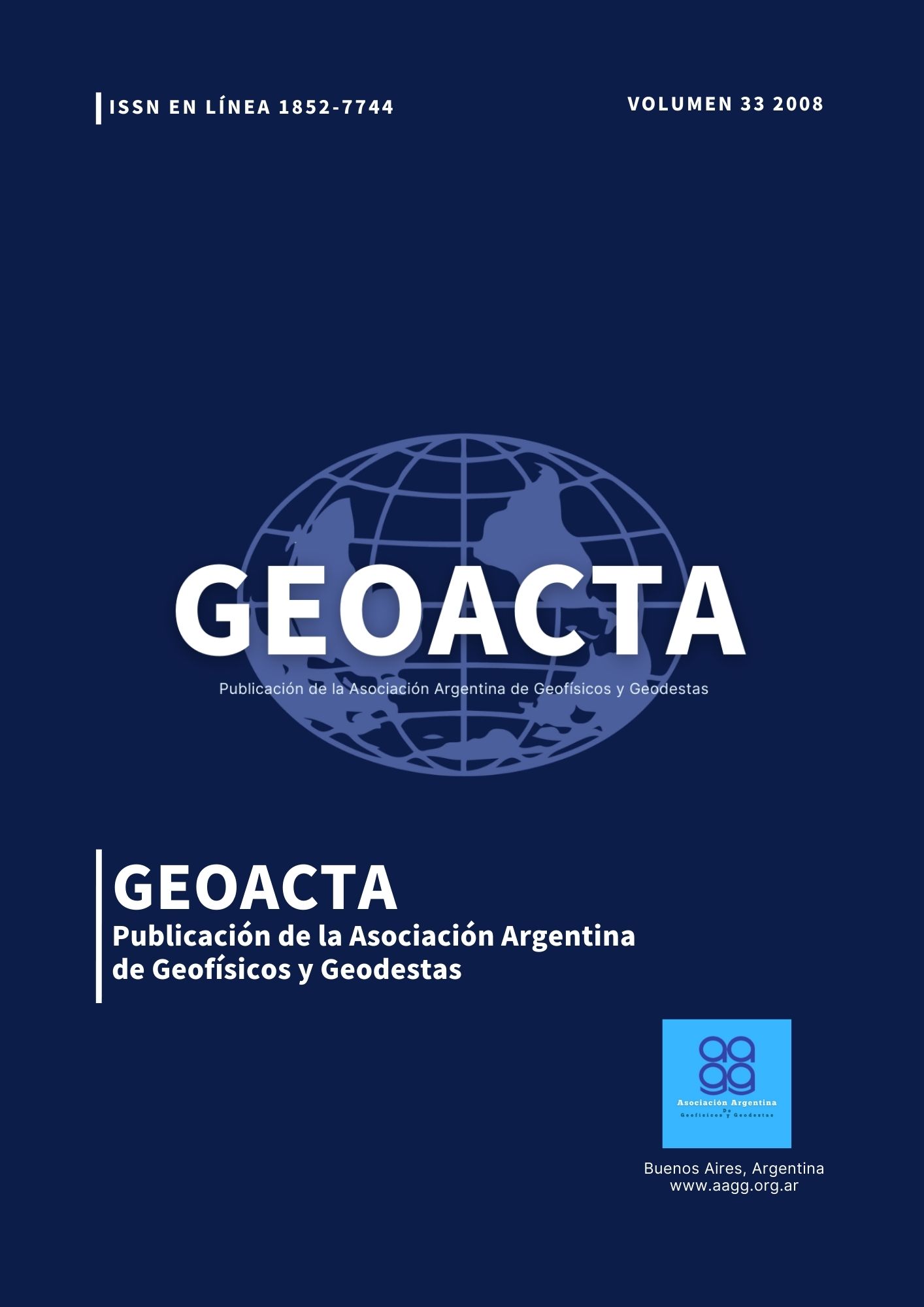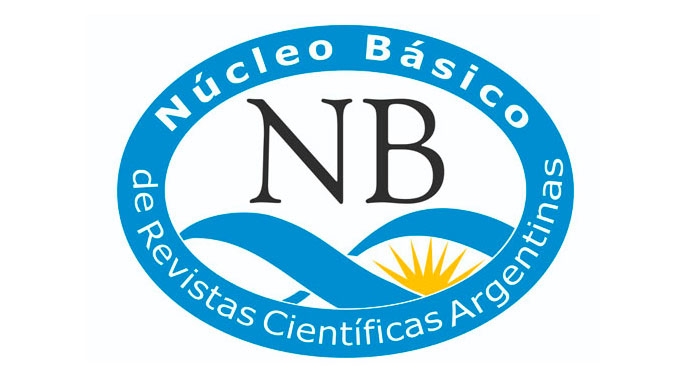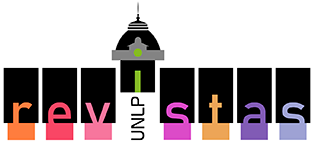Estudios de exploración geoeléctrica sobre la Formación Marifil entre Puerto Madryn y Telsen (provincia de Chubut)
Palabras clave:
Prospección Geoeléctrica, – Sondeos Eléctricos Verticales, Formación Marifil, Evolución de paisaje, Telsen, Puerto MadrynResumen
Entre las localidades de Puerto Madryn (42 o 30 S y 65o 00´ W) y Telsen (42 o 40´ S y 67o 00´ W) se llevan a cabo estudios geomorfológicos cuyo objetivo es conocer la evolución del paisaje labrado desde el Jurásico. Las volcanitas de la Fm Marifil son los principales afloramientos ígneos, constituyen el basamento en el área y se manifiestan en superficie en forma de lomadas que tienden a alinearse en una dirección norte-sur. En este estudio, se realizó una prospección geoeléctrica en aquellos sectores en que la Fm Marifil se encuentra cubierta por depósitos sedimentarios. Con la finalidad de identificar los espesores de la cobertura sedimentaria, como así también variaciones en la morfología y profundidad del basamento, se realizaron 16 Sondeos Eléctricos Verticales (SEV). Para cada sondeo se empleó la configuración tetraelectródica de Schlumberger y las curvas de campo fueron interpretadas automáticamente a partir de los sucesivos procesos de reajustes. Los modelos de capas geoelétricas fueron obtenidos con un error inferior al 2,5%. Para la interpretación geológica de cada modelo geoeléctrico se tuvieron en cuenta tanto la información de la geología de la región como los datos de un pozo de exploración, cuyos perfilajes eléctricos y litología fueron empleados para la parametrización de los sondeos. Dichos modelos permitieron establecer las variaciones del espesor sedimentario sobre la Formación Marifil, alcanzando en algunos sitios los 174 m. Una transecta al sur de Telsen define una progresiva profundización del basamento hacia el sur
Descargas
Citas
Alric, V., Haller, M., Feraud, G., Bertrand, H. y Zubia, M. 1996. Cronología 40Ar/Ar39 del volcanismo Jurásico de la Patagonia Extrandina. XIII Congreso Geológico Argentino y III Congreso Exploración de Hidrocarburos, Buenos Aires. Actas (5): 243-250.
Ardolino, A. L. y Franchi, M. 1996. Hoja Geológica 4366-I. Telsen. Provincia de Chubut. Subsecretaría de Minería de la Nación. Boletin 215. Buenos Aires.
Benson, R., Glaccum, R. and Noel, M. 1988. Geophysical techniques for sensing buried waste and waste migration. Technos Inc, USA. pp: 91 - 116.
Bobachev, A., Modin I., Shevnin, V. 2000. IPI2WIN Software. Moscow State University. Moscov. 80
Cortiñas, J., S. 1996. La Cuenca de Somuncura - Cañadon Asfalto: Sus límites, ciclo evolutivo del relleno sedimentario y posibilidades exploratorias. XIII Congreso Geológico Argentino y III Congreso Exploración de Hidrocarburos, Buenos Aires. Actas (1): 147 - 163.
Haller, M., Meister. A., Monti, A. y Weiler, N. 2000. Hoja 4366-II Puerto Madryn, Provincia del Chubut.
Servicio Geológico Minero Argentino, Boletín 289. Buenos Aires.
Navarro, E. y Labudia, C. 2004. Avances en el estudio de depósitos sedimentarios del Grupo Chubut y Formación La Colonia en el área de Telsen (Pcia. de Chubut). X Reunión Argentina de Sedimentología, San Luis. Resúmenes: 115-116.
Orellana, E. 1982. Prospección geoeléctrica en corriente continua. Segunda edición corregida y ampliada, Ed. Paraninfo, Madrid. pp 579.
Plusagua, 2004. Pozo exploratorio a los efectos del abastecimiento de agua Bajo el Gualicho. Informe inédito. Bahia Blanca.
Vander Velpen, B. 1988. Resist version 1.0. Software. ITC Msc. Research Project. Netherland.
Widhausen, A. 1921. Informe sobre un viaje de reconocimiento geológico en la parte nordeste del territorio del Chubut, con referencia especial a la cuestion de la provisión de agua a Puerto Madryn. Ministerio de Agricultura de la Nación. Dirección General de Minas, Geología e Hidrología, Boletin 24, Serie B (Geología), Buenos Aires. pp 101.
Zhody, A., R. 1973. A computer program for the automatic interpretation of Schlumberger sounding curves over horizontally stratified media geological survey. Spriengfield. USA.
Zhody, A., R. 1989. A new method for the automatic interpretation of Schlumberger and Wenner sounding curves. Geophisycs, USA. 54(2): 245 - 253.
Descargas
Publicado
Cómo citar
Número
Sección
Licencia
Derechos de autor 2008 Edgardo Navarro

Esta obra está bajo una licencia internacional Creative Commons Atribución-NoComercial-CompartirIgual 4.0.
A partir de 2022 (Vol. 43 número 2) los artículos se publicarán en la revista bajo una licencia Creative Commons Atribución- NoComercial-CompartirIgual 4.0 Internacional (CC BY-NC-SA 4.0)
Acorde a estos términos, el material se puede compartir (copiar y redistribuir en cualquier medio o formato) y adaptar (remezclar, transformar y crear a partir del material otra obra), siempre que a) se cite la autoría y la fuente original de su publicación (revista y URL de la obra), b) no se use para fines comerciales y c) se mantengan los mismos términos de la licencia.
Previo a esta fecha los artículos se publicaron en la revista bajo una licencia Creative Commons Atribución (CC BY)
En ambos casos, la aceptación de los originales por parte de la revista implica la cesión no exclusiva de los derechos patrimoniales de los/as autores/as en favor del editor, quien permite la reutilización, luego de su edición (posprint), bajo la licencia que corresponda según la edición.
Tal cesión supone, por un lado, que luego de su edición (posprint) en Revista GEOACTA de la Asociación de Geofísicos y Geodestas las/os autoras/es pueden publicar su trabajo en cualquier idioma, medio y formato (en tales casos, se solicita que se consigne que el material fue publicado originalmente en esta revista); por otro, la autorización de los/as autores/as para que el trabajo sea cosechado por SEDICI, el repositorio institucional de la Universidad Nacional de La Plata, y sea difundido en las bases de datos que el equipo editorial considere adecuadas para incrementar la visibilidad de la publicación y de sus autores/as.
Asimismo, la revista incentiva a las/os autoras/es para que luego de su publicación en Revista de la Asociación de Geofísicos y Geodestas depositen sus producciones en otros repositorios institucionales y temáticos, bajo el principio de que ofrecer a la sociedad la producción científica y académica sin restricciones contribuye a un mayor intercambio del conocimiento global.












